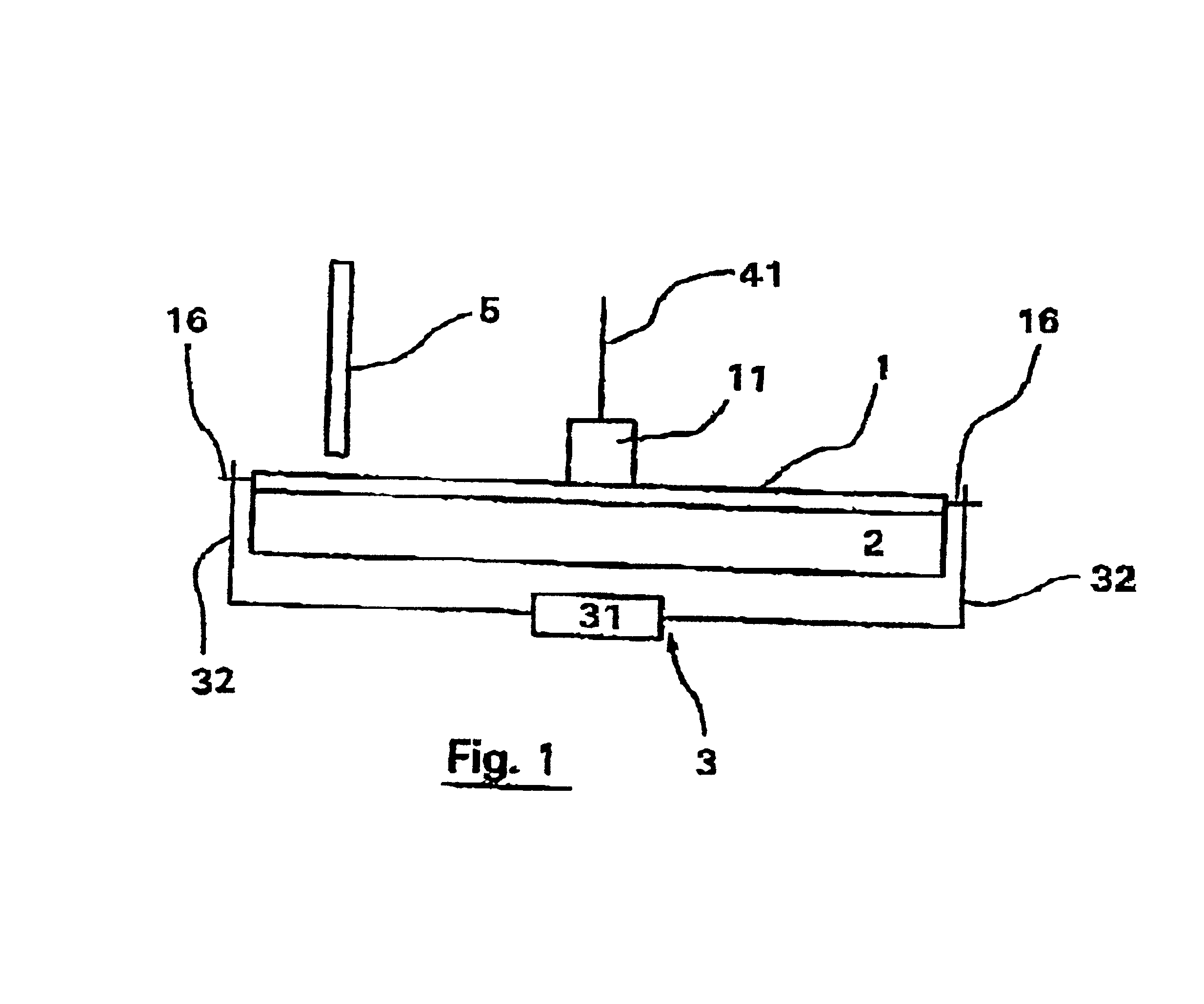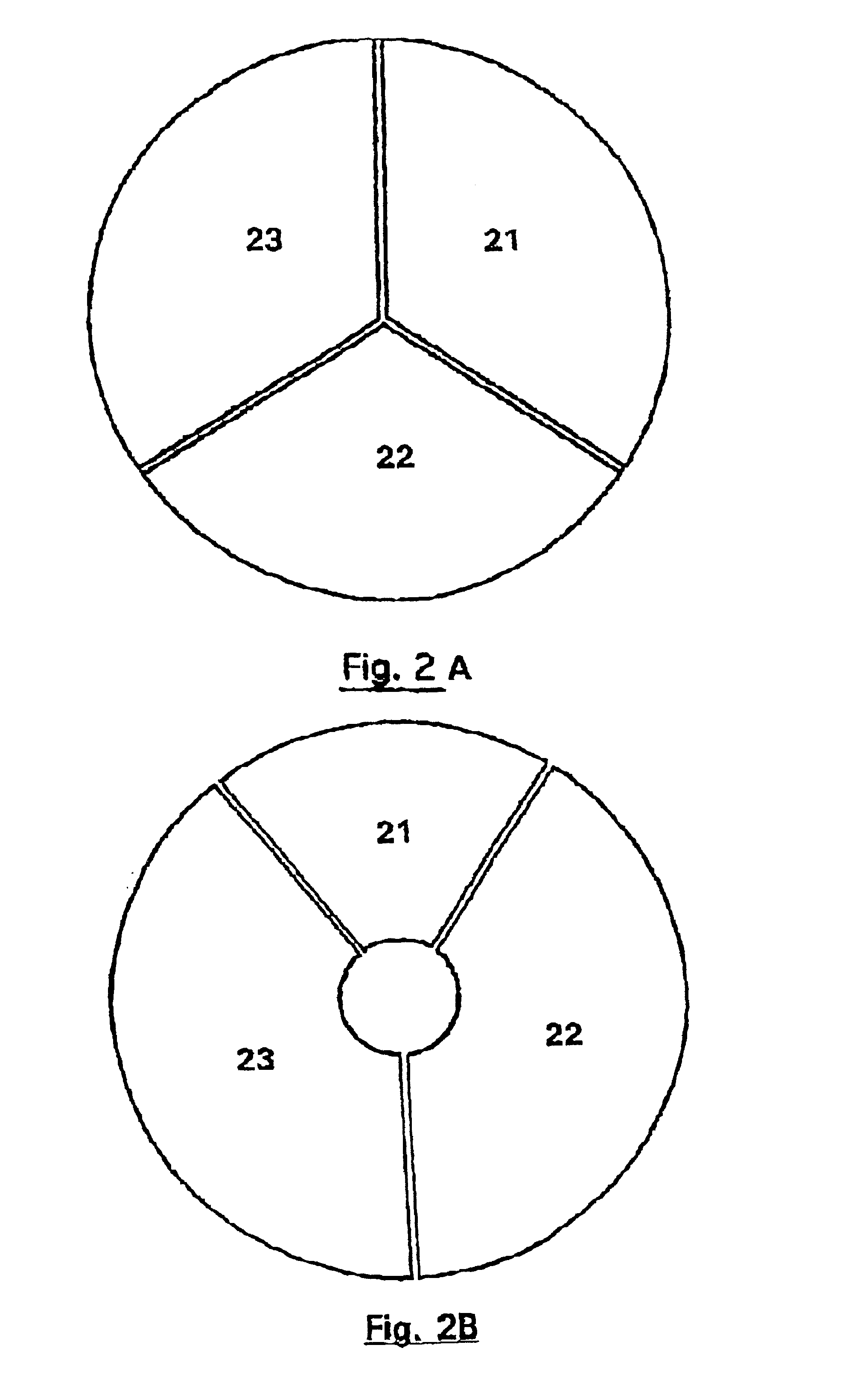Device for thermo-dependent chain reaction amplification of target nucleic acid sequences, measured in real-time
a technology thermodependent chain reaction, which is applied in the field of target nucleic acid sequence detection, can solve the problems of time-consuming, inability to guarantee the freedom of one amplification reaction from the other, and inability to ensure the homogeneity of volume and reagent concentration from one tube to the other, so as to achieve the effect of miniaturisation
- Summary
- Abstract
- Description
- Claims
- Application Information
AI Technical Summary
Benefits of technology
Problems solved by technology
Method used
Image
Examples
example 1
Simplified Embodiment of the Instrument of the Invention
The system for detecting and quantifying target nucleic acid sequences shown in FIG. 1 comprises a circular cartridge of plastic material 2 mm thick with a diameter of 5 cm. This cartridge (1) is provided with a central reservoir (11) and will be described in more detail with reference to FIGS. 3 and 4. In the present embodiment, the capacity of the reservoir is 400 .mu.l. Its floor is flat but it should be noted that in other embodiments, it may be domed to facilitate the passage of fluid into the chambers without the formation of air bubbles, in particular at the end of distribution when the reservoir is almost empty.
The system also comprises a heating plate (2) in direct contact with the lower surface of cartridge (1) and means (3) for displacing cartridge (1) with respect to the heating plate (2). These displacement means include a micrometer (31) connected to two axles (32) that co-operate with two lugs (183) on cartridge ...
example 2
Improved Circular Cartridge
FIGS. 5 to 10 show an example of a circular cartridge with certain modifications over the cartridge of Example 1.
This cartridge is provided for use in a closed system, i.e., the reaction chambers (13) have no other opening apart from the inlet for channel (12). The cartridge is constituted by two elements that fit one in the other, the lower portion, or base, is shown in FIGS. 5 and 6, and the upper portion, or cover, is shown in FIGS. 7 and 8. The assembly of the two portions is shown in FIGS. 9 and 10.
This cartridge is charged as follows:
The operator places the extract of nucleic acids to be analysed in the central reservoir. The disposable cartridge is placed in the instrument. This latter produces an underpressure in the cartridge (P=0.05 bars, approximately), for example using a pump (42). The pressure is then re-established, which enables the fluids to engage in the channels and to fill the peripheral reaction chambers. Thus, compared with the instru...
example 3
Rectangular Cartridge
In this example, illustrated in FIG. 11, the reservoir is no longer central but to one side and the motion of the cartridge is no longer necessarily rotational, but may be translational.
The distribution and closing modes can be exactly as described for the circular mode described for Example 2.
Alternatively, the fluids can be distributed by increasing the pressure. They enter into the first portion of the channel (121) wherein the sum of the volumes is slightly lower than the volume of sample to be analysed (nucleic acid extract). The second portion of channel (122) is constituted by a glass capillary with a much smaller diameter, incorporated into the plastic system, as shown in FIG. 12. Its advantage is to create a pressure drop phenomenon, allowing the first portion of the channels to be homogeneously filled (if one channel fills faster than another as the pressure increases, this phenomenon stops fluid advancing in the filled channels until the others have b...
PUM
| Property | Measurement | Unit |
|---|---|---|
| diameter | aaaaa | aaaaa |
| Tm | aaaaa | aaaaa |
| Tm | aaaaa | aaaaa |
Abstract
Description
Claims
Application Information
 Login to View More
Login to View More - R&D
- Intellectual Property
- Life Sciences
- Materials
- Tech Scout
- Unparalleled Data Quality
- Higher Quality Content
- 60% Fewer Hallucinations
Browse by: Latest US Patents, China's latest patents, Technical Efficacy Thesaurus, Application Domain, Technology Topic, Popular Technical Reports.
© 2025 PatSnap. All rights reserved.Legal|Privacy policy|Modern Slavery Act Transparency Statement|Sitemap|About US| Contact US: help@patsnap.com



